Welcome to FISH FOOD TIMES

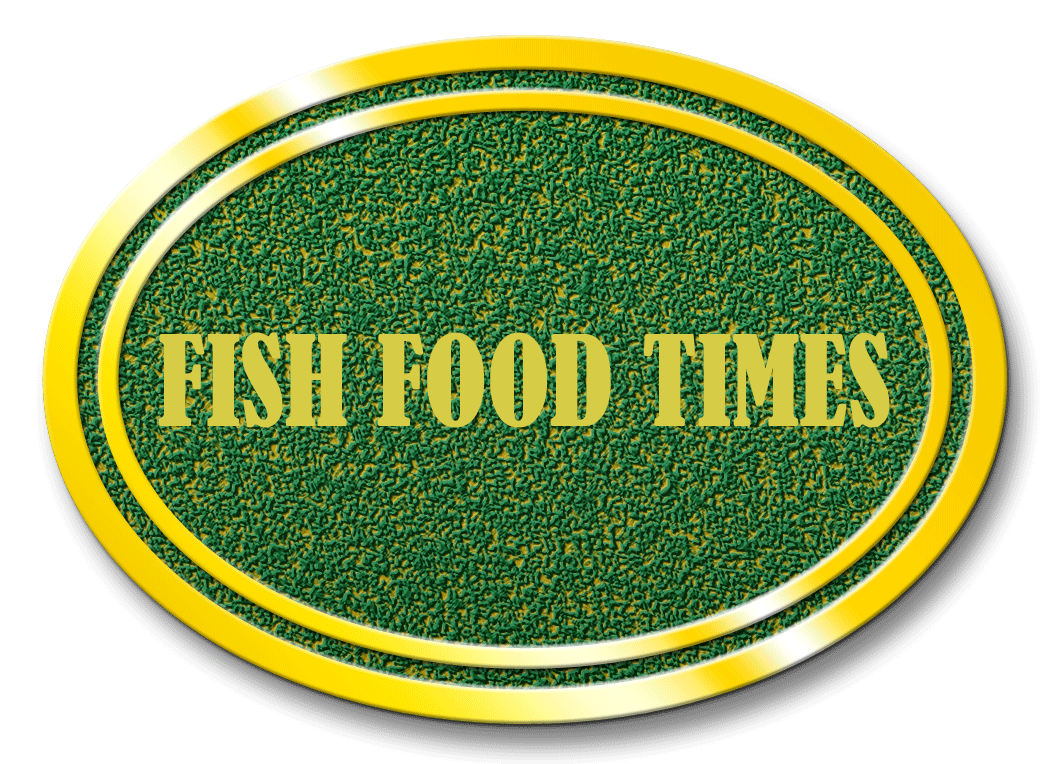
Dec. 2013 issue No.120

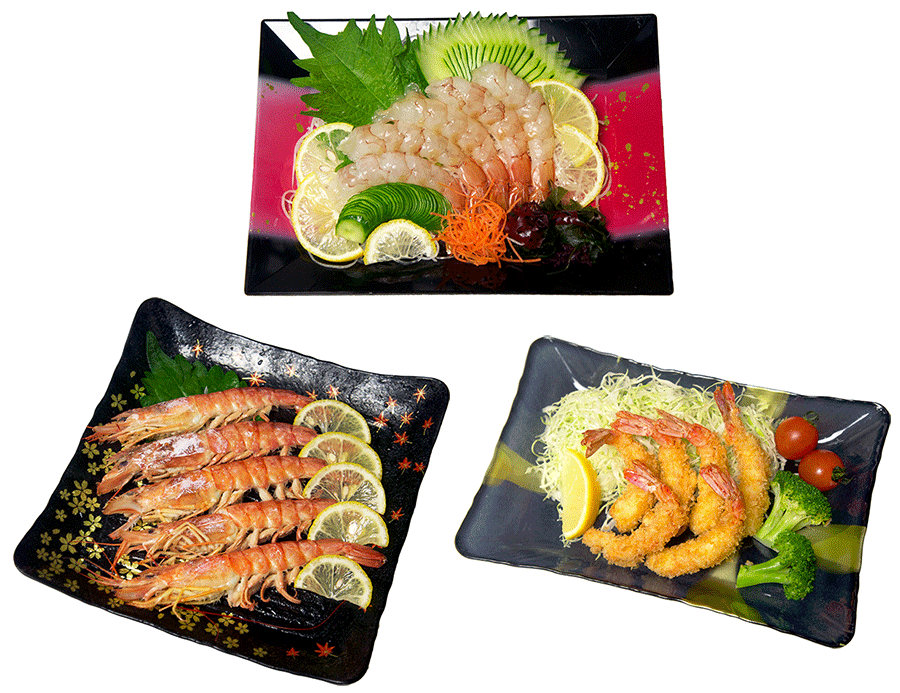
The charm of Argentine red prawns
The price of prawns soars.
In present conditions prawns, the speculation of the black tiger no head prawns 16/20 size is 4,000 yen (1.8 kg) is before and after it. The same thing is approximately 2,000 yen one year ago, and the way of rise is surprising. As for the price, the situation of a little different thing is approximately by a product in India, in Indonesia, in Thailand.
One of the price of prawns remarkable rise factors is "the weak yen" that progressed from about last autumn. And, by an unidentified ill spread called EMS (early death syndrome to destroy the digestive organs of prawns) occurring in a Southeastern Asian prawns culture place from last year, the amount of production of prawns decreases sharply, and it is a thing by the balance of supply and demand having collapsed that it is thought as another factor.
The EMS does not infect a person, and a person does not have the harm even if I eat infected prawns. A shrimp before the growth is often infected with EMS, and the mass death of the childish prawns in the nursery seems to lead to production decrease. It is chief producing center Thailand of vannamei prawns to spread out, and, as for the amount of production of vannamei prawns, there was blight in particular 550,000 tons in Thai last year, but is to seem to be depressed until 300,000 tons of breaking this year.
The EMS occurs in not only Thailand but also each other Asian countries including China and Malaysia, and, as a result, a price soars by the understock of prawns. Furthermore, the high quality prawns such as a prawn and the lobster receive the aftermath by "a food camouflage problem" shaking society from about October of this year, and a price suddenly soars recently.
The black tiger (cow prawns) of the lower image was a senior than bannamei prawns at the point to be cultured of prawns, and it was introduced into Thailand by a method called the Intensive type culture in the 1980s by Taiwan and it spread out from there to each Southeastern Asian country and grew up.
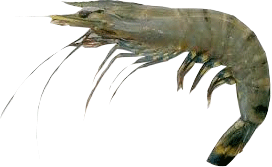
However, the 1990s begins, and, in the nursery of black tiger prawns, viral diseases such as yellow head disease or white Pott's disease spread, and there is the past when I put on large damage.
The culture of shrimps method is divided into three kinds , @ carelessness type, A half Intensive type, B Intensive type, by difference in cultured density. Of course a Intensive type is more efficient with a high yield. Various factors such as @ leftover with the megadose of the artificial feed, Asedimentation of the excrement to the bottom of the pond, BAggravation of the quality of the water, Cstress caused by overcrowded culture occur at the same time, and, in the case of this Intensive type culture, the risk of the disease outbreak increases.
The culture of black tiger shrimps captures a wild female feed shrimp and lets you lay eggs artificially in child prawns incubation facilities. However, most of the wild feed shrimps have been already often infected with a disease. The nursery is easily broken if some kind of pathogens move to prawns because pro-prawns infected with a disease enter the Intensive type rearing pond that is at increased risk of the attack.
The survival rate in the black tiger prawns culture continues falling year by year and comes to turn worse before the number of the cultured prawns which I put into the pond breaks finally 50% recently. Though I was told, "the prawns culture collects initial investment in two years, and one house is built before in three years", I do not come to make a profit as in the past in these days.
The black tiger prawns culture was easy to suffer from a disease, and, furthermore, it became the production situation of the low result by low growth in this way. And it was approached in the prawns culture place of Asia by the need to change prawns targeted for culture and would change it into a western white class cultivated in North America, Central and South America at the time from the about the end of 1990s.
With the western white class, a scientific name is Litopenaeus vannamei, a kind of the prawn department and acts as the relative of the black tiger and is classified in Central and South America system white, and a lower image is the vannamei prawn of the ringleader disturbing the Japanese world now.

Because I could purchase a pro-shrimp (specific pathogen free:SPF) which was not infected with a specific pathogen from Hawaii in the case of vannamei prawns, the fear that feed prawns brought in a pathogen like black tiger prawns in the pond of the prawns culture disappeared.
The switches from the black tiger prawns which were the main force of the prawns culture in Southeast Asia to bannamei prawns advanced to this bannamei prawns for a reason, "productivity was high because I could cultivate it repeatedly every year in the same pond" in comparison with black tiger prawns like a brick.
However, in the Southeastern Asian prawns cultured facilities, biosecurity measures are not perfect as North American it. Therefore, it is that it was foreseen that it will be possible in the vannamei prawns in due course judging from the eyes of the expert of that field to some extent soon to have taken place by culture of black tiger shrimps business in the past.
And a western blue (Litopenaeus stylirostris) kind is already with introduction finished as the measures experimentally. However, it is thought that the problem of the risk due to such a disease does not disappear as far as after all I will continue a method called "the intensive culture" that is high risk, high return as a basic problem in future.
It is a method to aim at the production of the high yield of 200,000 from 50,000 in the year by giving prawns the solid feed which this intensive culture gives off the young prawns from 100,000 to 500,000 in the pond of the size less than 1 hectare and supplies oxygen with a machine pump in the pond and produced in a factory.
On the other hand, there are the totally different methods called "the carelessness type culture". The childish prawns from 5,000 to 20,000 are put in a pond of 5-20 hectares and feed it a natural meal with the pump without supplementing it with oxygen and seem to be able to produce only 10,000 from 3,000 there in the year.This is the way that a basic way of thinking is different from the intensive culture in, and the pattern that is a low yield is one example to produce the stable prawns of the low risk low return.
In a Southeastern Asian prawns production of Thailand place, I do not permit the guess how a production method will change into vannamei prawns culture business triggered by a disease called the EMS that I had in future. However, I think that even vannamei prawns check that they will receive the retaliation that, as a result, is serious following black tiger prawns and might be accumulated as experience intellect when I run after only effectiveness in business to be cultured.
The causation concerning the import cultured shrimp that a price rises suddenly and the environment put are just what they spoke it to here. It cannot be out of the picture, and of course only natural prawns rise to the price in the same way while a cultured shrimp soars about the, on the other hand, natural prawns.
However, there is the shrimp which I can express even with "the honor student of the price of prawns" if I say in that.
It is "a natural Argentine red prawn" of the lower image.
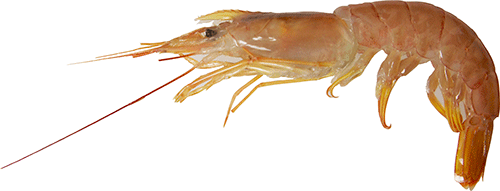
In about December one year ago, as for the market price situation of Argentine red prawns, L1(10/20 size) was 950/kg, L2(20/30) 750 yen/kg, a price of L3(30/40) approximately 650 yen/kg. The speculation of the end of November became L1(10/20) 1,300 yen/kg, L2(20/30) 1,150 yen/kg, L3(30/40) around 1,000 yen/kg in last month approximately one year later, and which size has risen by approximately 40% in price, too. As for the extra-large L1 size to include one size as for around 70 g, a cost price per one is only 87 yen.
When the price of capitate Australian tiger prawns of the U6~6/8 size of the size approximately similar to this goes with current market price, 1.5 kg do a little over 5,000 yen. The price per one of capitate Australian tiger prawns is approximately 200 yen when I premise this price.
The cost price per one of Argentine red prawns does not cost half of the Australian tiger prawns in this way either. Besides, there is the superior aspect to be a thing of "the freshness for the sashimi" that it is possible for the most that these prawns are carried in to Japan "to eat raw" as basics.
The history is relatively superficial in Japan, and it is the Argentina red prawn which was not so common until recently, but the recently at last presence gradually increases.
Originally these prawns are called "Olympics prawns" and increase to spring out by intense force at the interval once in four years. In one, the prawns repeated a pattern that fishery fell at one sweep for a while from the next year when they increased to spring out. However, even a Japanese market came to come into the limelight suddenly because fishery came to be stable every year, and stable fishery continued recently from the area of the age that El Nino produced for several years.
There is a big gulf of 300km 200km, the north and south east and west called Golfo de San Jorge opening off the coast of big city Comodoro Rivadavia which prospers because oil and natural gas produce it in the suburbs in the Tube state of the southern part of South America Argentina. In some limited areas of the inside, the most of Argentine red prawns are that they are fished.
Argentine red prawns are the prawns which prawns Solenoceridae belongs to. It becomes the big group, and there seems to be swimming at high speed, and there are a little different habits not to be produced immediately after having sprung out explosively as wrote down earlier. Because it is very cheap and finishes it for work cost by being able to right capture it by "net a good haul of fish" by a net if I am the perfect timing, the product price than other prawns is very low and seems to be able to control it.
The Argentine government establishes it to calculate the tax of these prawns at weight. Because the yield of taxes decreases by just that much when I make red prawns the prawns of no head, the most are exported with a capitate form. And most are exported for Europe, but because they are made of rapid freeze methods such as IQF on a ship assuming sashimi use when there is it for Japan, it is very fresh and is the product which I distinguish it from the product for Europe definitely, and was made of high quality.
It features it that there is much unevenness of big things and small things size-like in the product partly because the Argentine red prawns finishing the life only in one year are very fast-growing, and the size changes every moment by time of the fishery.
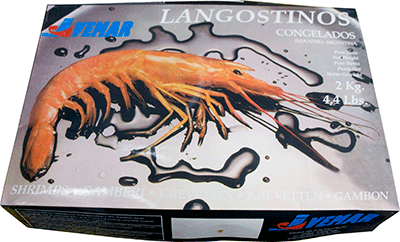
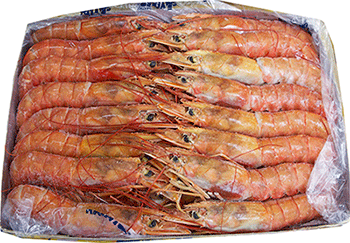
Because the vannamei prawns of the lower image are "container freezing standards ," water and prawns are frozen as blocking together. And, as for the product standard form of Argentine red prawns, it is not "a container freezing standard" unlike black tiger prawns and vannamei prawns in "IQF" to know it to see the upper right image. Therefore, it is not necessary to subdivide the Argentine red prawns after doing shower thawing using the water and I subdivide it with freezing it and can do it to a product. From this, a method to sell while hanging time little by little on the site in a refrigeration temperature zone, and defrosting it of the retail is possible, and it has a long freshness level in the straight food, and there is the kept advantage.
And the upper image is 10/20(2kg) size of Argentine red prawns, but it is a big characteristic of the other which this product has to be the very careless standard "that the minimum is 20, and up to approximately 40 prawns enter" in 2 kg so that there is it for this indication.

Because it is included in 1.8 kg as 70 of them from 52 of them, in the case of a standard of 13/15 of the vannamei prawns of the upper image, I know that one size is size from 25 grams to 35 grams. And it is size from 50 grams to approximately 100 grams and, in the case of the Argentine red prawns of the upper image, can calculate that the prawns of scattered big things and small things different of the size very enter in this by one hit when I divide it. However, the standard called 10/20 is so very size with the differences, but I virtually give a warning when "they must not complain in various ways" from a beginning, and, anyway, the causes are careless standards.
In the case of a standard of this 10/20, around 33 of them are often found when they really count it. Therefore there is not the big problem, but the cost accounting per one is big and will be out of order even if I calculate when it is 70 grams per one if only 25 entered.
By the way, it was finally this year for the fisheries section with a season to invite the year-end sales battle to make maximum sales in the year. How sell the prawns which are year-end anchor product; in the case of this year the prawns whole such; there should be the thing which really has a pain in a head as for the fisheries person in charge to be in a price state.
It is thought that the sale of "the capitate prawns" which make the biggest needs a constant seller product of New Year dishes in the year-end sales battle in that during the year is a scene to right use the head for for them. After all, in the case of this year, I think that there is a place of the big activity to "Argentine red prawns" taking away with this magazine now issue.
At the present, it is three pieces of images of the first page that this Argentine red shrimp showed that I can show very superior cost performance in form to be seen concretely.
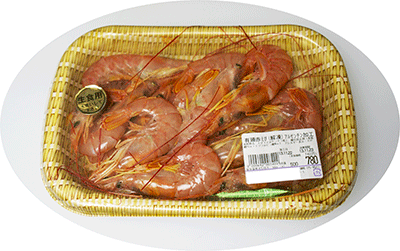
I purchased Argentina red prawns of sale price 780 yen sold in the fish section of a certain department store and did it with the materials of three works of the first page image.

Because I received it for 16 in that, the sale price per one was approximately 49 yen.
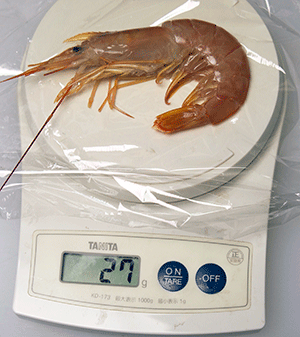 @
@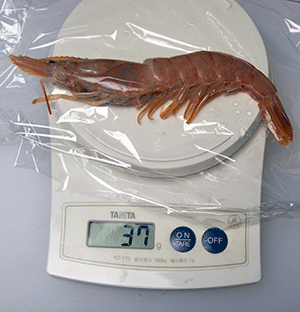
As for the difference in weight, 27 g at the minimum, a maximum were 37 g.
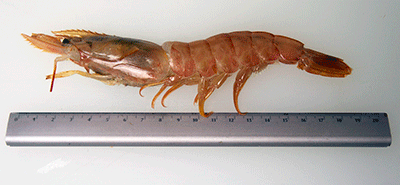
The length did not feel the conspicuous difference by the length as 19 centimeters from 17 centimeters.
Probably, judging from size by this weight and length, the standard of these Argentine red prawns was able to suppose that it might be L3(30/40).
Because the present conditions speculation of L3 is approximately 1,000 yen/kg; of approximately 30 yen per one of these prawns can calculate. However, if this is a calculation with the present conditions market price to the last, and the stocking is done early It is thought about what I was able to obtain for 700 yen - 800 yen/kg. If this company has been secured for 800 yen/kg; the cost price per one of these prawns of approximately 23 yen is calculated.
In other words I add all 16 prawns cost prices that I used for three articles of the first page image and can calculate it with 480 yen from 368 yen. Because I should be able to do it approximately 1,200 yen - 1,500 yen if I set the sale price as the product in these, it may find this 60% - approximately 75% when I calculate a total level case rate without being slightly coarse, and including the material costs without a consumption tax.
A stocking timing whether became late whether the time when I laid in stock of Argentine red prawns was early or is big and influences it, but can calculate the profit that even products that it is easy which I only merely subdivided into 780 yen with 16 are enough for for the seller side. And I may more strongly raise a value case rate if I do the commodification such as the first page image as well as it.
In addition, it should be the expenditure that is not high at all if it is a price of 780 yen in 16 of them in capitate shrimps for the visitor. And I can enjoy such cooking with these prawns only if a visitor is determined. The most of the prawns product rise suddenly and, judging from the situation of these days when it becomes hard to purchase it, must easily have you feel it if the cost performance of these Argentine red prawns is very big.
The fish catches of red prawns in Argentina of this year seemed to be ordinary approximately in the previous year, and there seemed to be approximately 13,000 tons and this about the quantity of import to Japan equally with the last year, too. Anyway there is a fact rising in price mainly on L3 size steadily as if the Argentine red prawns market price is with in it because the speculation of black tiger prawns and vannamei prawns is in such a situation. However, as for this, there is the thing which I cannot stop as a flow of the present market price.
The stocking of the year-end product including prawns product is already over in the spot of the retail and thinks that what company is getting ready for going into the action, but should prepare for a very severe result having possibilities to wait if I just follow a way of thinking until the last year about the prawns product.
It is the same in the year-end sales battle not only daily business how you dig up the needs of the visitor by a new product and a new way of thinking.
As for the year-end sales battle of this year, "Argentine red prawns are interesting!"

Date of updating |
Dec.1, 2013 |
Food commerce contribution sentence
| Food commerce contribution sentence (foregoing volume) |
An opinion and the communication are to info@fish food times